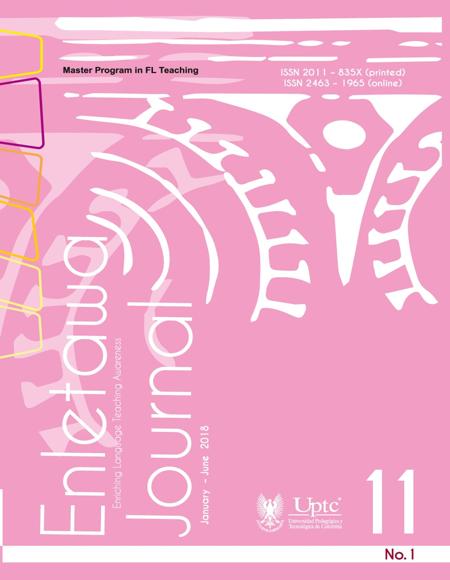El uso de los sentimientos dentro de la clase de Lengua Extranjera para mejorar la habilidad escrita mediante el uso de Talleres de Escritura de Historias

Resumen
Este trabajo pretende analizar el papel que juegan los sentimientos y emociones cuando son traídos dentro del salón de clase de la lengua extranjera, inglés con estudiantes de grado octavo. Los estudiantes fueron alentados a dejar aflorar sus sentimientos y emociones a través del desarrollo de diez talleres basados en la escritura de historias cortas a partir de sus propias experiencias de vida. Los resultados dejaron ver cómo los sentimientos y las emociones son una parte de los estudiantes que no puede ser evitada en el proceso de enseñanza- aprendizaje, porque son parte de su desempeño en el salón de clase. También se concluye que el aprendizaje auto-dirigido y un ambiente positivo en el aula de clase son parte de la influencia observada al tomar esta parte emocional de los estudiantes dentro del salón de clase durante el aprendizaje de la lengua extranjera inglés.
Palabras clave
Sentimientos, Emociones, Historias Cortas, Habilidad Escrita, Taller
Citas
Bowman, M. (1994). Using video in research. Spotlights, 45. Scottish Council for Research in Education. Retrieved from: http://www.sfu.ca/media-lab/ cmns362/Spotlight45.pdf
Broks, P. (2003). Into the silent land. London: Atlantic.
Calle, M., De Cleves, N., and Velázquez, B. (2011). NOVA: Publicación Científica en Ciencias Biomédicas. Incidencia de la Inteligencia Emocional en el Proceso de Aprendizaje. Retrieved from: http://www.unicolmayor.edu.co/invest_nova/NOVA/ NOVA15_REVIS2_INTELIG.pdf
Carr, W., and Kemmis, S. (1986). Becoming critical: Education, knowledge and action research. Lewes: Falmer.
Cherry, K. (2014, October). About. Com Psychol. Overview of the 6 Major Theories of Emotionogy. Theories of Emotion. Retrieved from: http://psychology.about. com/od/psychologytopics/a/ theories-of-emotion.htm
Coe, N., and Rycroft, R. (1983). Writing skills. A problem-solving approach. Teacher´s book. United Kingdom: Cambridge University Press.
Cuesta, L., and Rincón, S. (2010). Short story student-writers: Active roles in writing through the use of e-portfolio dossier. Colombian Applied Linguistic Journal, 12, 99-115.
Damasio, A. (1994). Descartes´ error: Emotion, reason and the human brain. New York: Putman.
Damsio, A. (2000). The feeling of what happens: Body, emotion and the making of consciousness. London: Vintage.
Damasio, A. (2004). Emotions and feelings: The Amsterdam Symposium. Neurobiological perspective: Studies and emotions and Social Interaction: Feelings and Emotions. United Kingdom: Cambridge University Press.
Dörnyei, Z. (2007). Creating a motivating classroom environment. In J. Cummins & C. Davison (Eds.), International handbook of English language teaching (pp. 719-731). New York, NY: Springer.
Fink, A. (2003). The survey handbook (2nd Ed.). United States of America: Sage Publications, Inc.
Hiemstra, R. (1994). Self-directed learning. In W. Rothwell & K. Sensenig (1999). The sourcebook for self- directed learning. Amsherst, Massachusets: HRD, Press.
Lodico, M., Spaulding, D., & Voegtle, K. (2010). Methods in educational research (2nd Ed.). San Francisco: Jossey Bass: A Wiley Imprint.
Lucke, M. (1999). Schaum’s quick guide to writing great short stories. U.S.A: McGraw Hill Companies. Retrieved from: http://books.google. com.co/books?id=qoYNPolwZC&printsc=frontcover&source=gbs_v2_summary_r&cad=0#v=onepage&q=&f=false
MacIntyre, P. (2002). Motivation, anxiety and emotion in second language acquisition. In P. Robinson (Ed.), Individual differences and instructed language learning (pp. 45-68). Amsterdam, nl: John Benjamins Publishing.
Marshall, C., and Rossman, G. (1989). Designing qualitative research. Newbury Park, CA: Sage.
Meyer, D. K., and Turner, J. C. (2006). Re-conceptualizing emotion and motivation to learn in classroom contexts. Educational Psychology Review, 18(14), 377-390.
Ministerio de Educación Nacional. (2012). Competencias Ciudadanas. Retrieved from: http://www. mineducacion.gov.co/1621/w3article-235147.html
Mubarak, M. (2013). The use of shortstories in EFL classroom: Advantages and implications. Labyrinth, An International Refereed Journal of Postmodern Studies (4), 2, 21-26.
Newmann, F. M. (1992). Student engagement and achievement in American secondary schools. New York, USA: Teachers College Press.
Osterholm, K. (1986). Listening, reading and writing analysis and application. Writing in the native language. B. H.Wing (Ed.). Middlebury, VT: Northeast Conference, l7 -43.
Patton, M. (1985). Quality in qualitative research: Methodological principles and recent developments. Paper presented at the American Educational Research Association, Chicago: IL.
Perry, B. (n.d). Creating and Emotionally Safe Classroom. Early Childhood Magazine Scholastic. Retrieved from: http://teacher.scholastic. com/professional/bruceperry/ safety_wonder.htm
Powers, W.T. (1992). Living control systems II. New Canaan, Connecticut: Benchmark Publications.
Punch, K.F. (1998). Introduction to social research: Quantitative and qualitative approaches. Thousand Oaks: Sage.
Reigeluth, C. (1999). Instructional design theories and models. NJ: Lawrence Erlbaum Associates, Inc.
Simonsen, B. (2007). Emotions and Feelings. A comparative presentation of Emotions and Feelings expressed by Antonio Damasio and expressed by William T. Powers in his Perceptual Control Theory. Retrieved from: http://www. psych-sci.manchester.ac.uk/ aboutus/events/csgconference/ proceedings.pdf#page=29
Strauss, A., and Corbin, J. (1997). Grounded theory in practice. United States: Sage Publications.
Sylwester, R. (1994). How emotions affect learning. Educational Leadership 52, (2), 60-65.
Yin, R. (1984). Case study research: Design and methods. Newbury Park, CA: Sage.